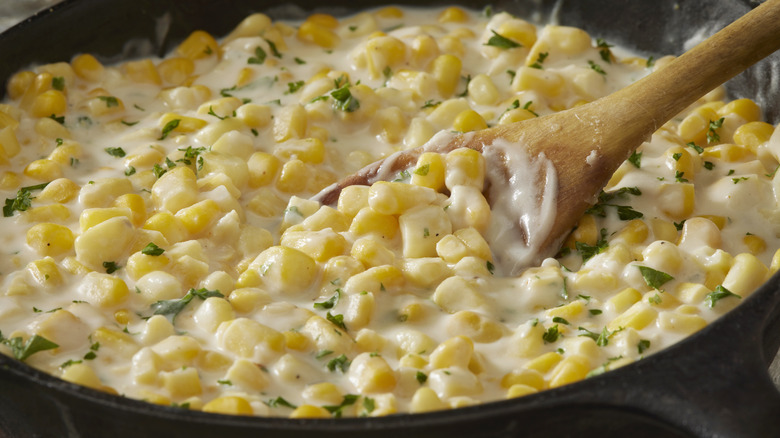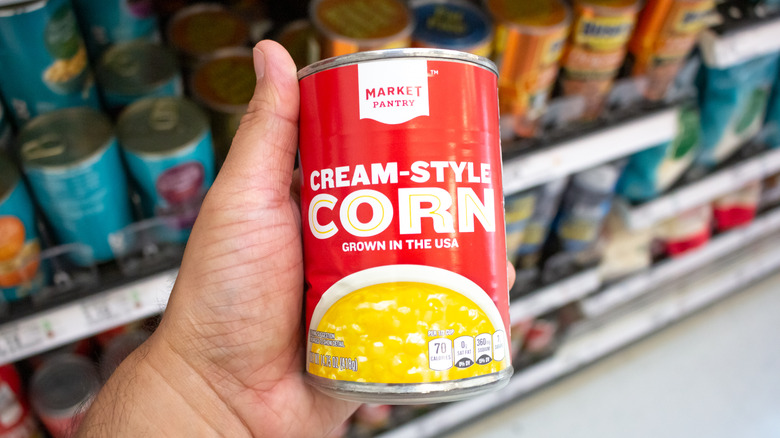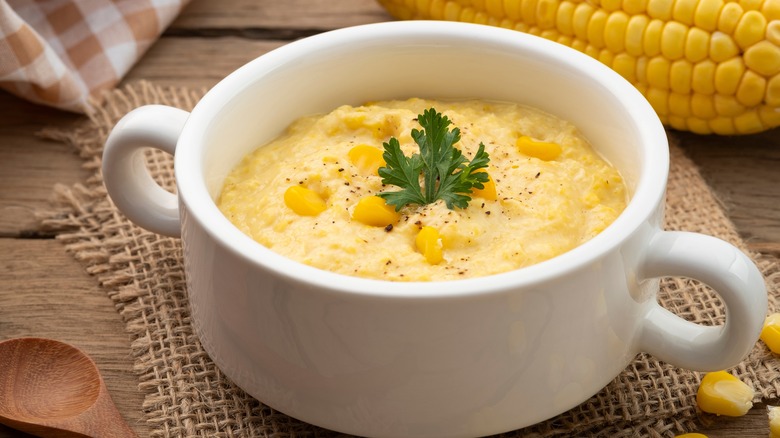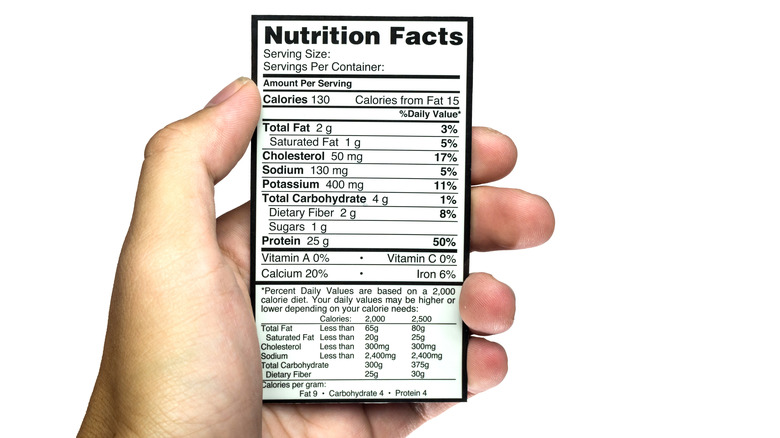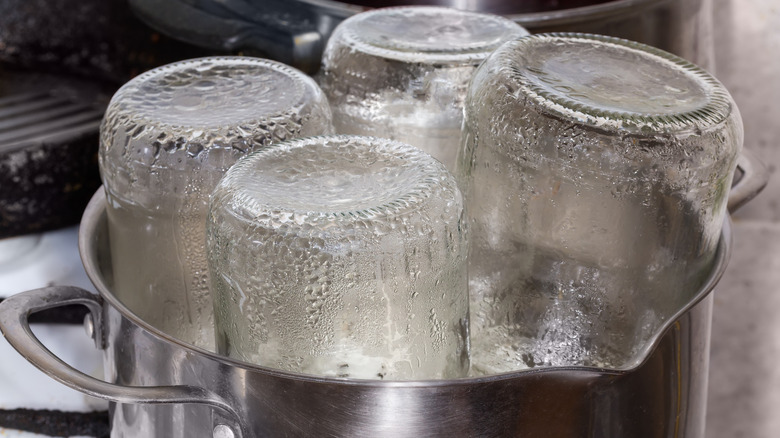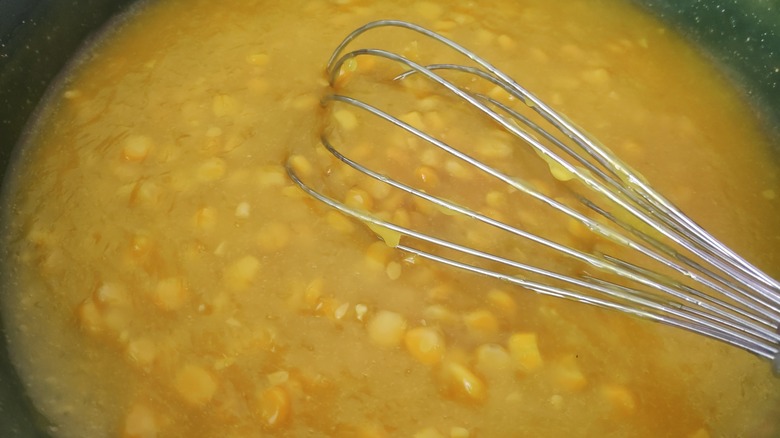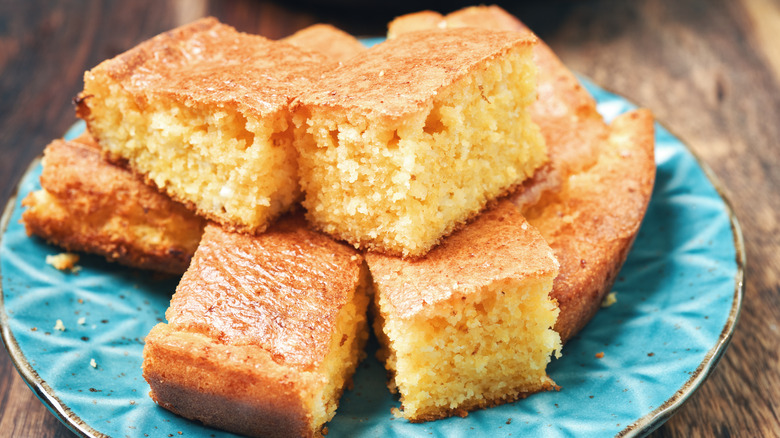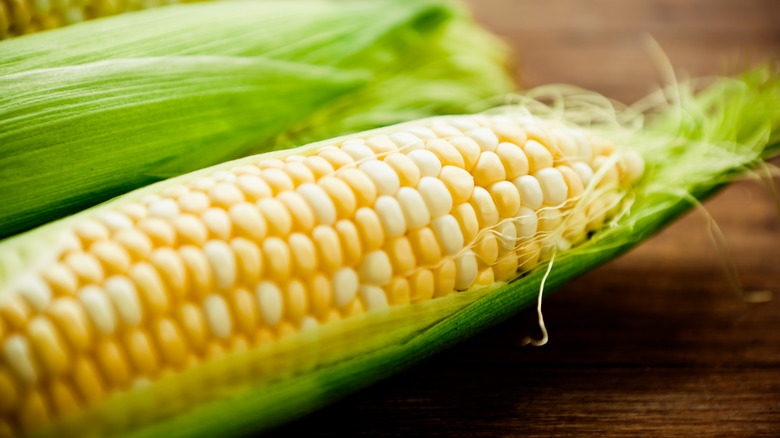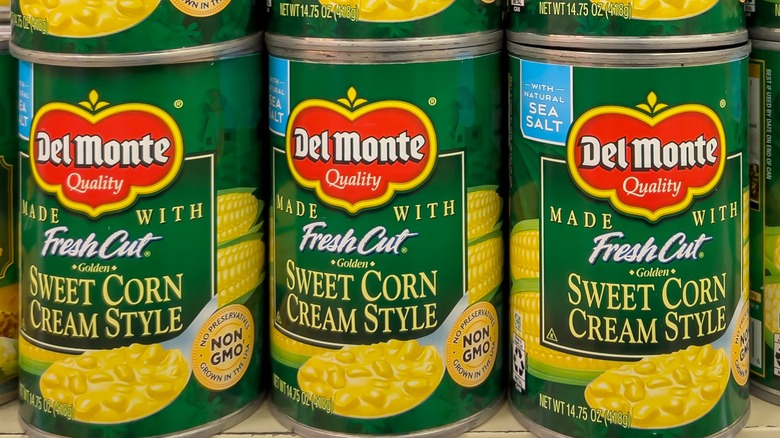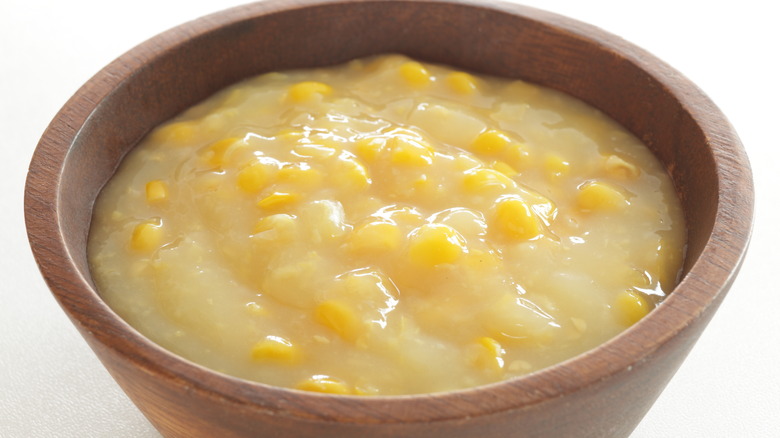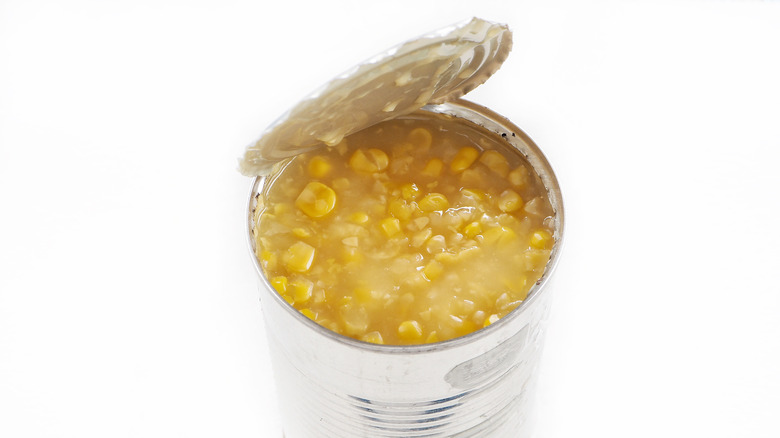Homemade Creamed Corn Vs Canned Creamed Corn: Everything You Need To Know
Creamed corn is a fall and winter holiday classic. Whether an ingredient, a side dish, or even a meal on its own, this versatile dish can be made at home or by popping open a can of cream-style corn. And despite the similar names, these two products aren't exactly the same, but both might deserve a place in your kitchen. If you've ever wondered what the difference between creamed corn and canned, cream-style corn is, don't worry: You've come to the right place. Spoiler alert: the most significant difference is the presence or absence of dairy, but that is not where the differences end.
This article dives into the nitty gritty of these two products, including taste, cost, and dietary implications. After reading, you'll be able to choose which one is right for you and when to use either one. You will become a creamed corn pro and be able to serve up a sweet holiday meal that your whole family will enjoy.
What should you expect from the canned variety?
Canned creamed corn is usually called "cream-style" corn because it typically contains corn, water, sugar, starch, and sugar. That's right: Cream is not one of the ingredients. Canned cream-style corn is a go-to staple for those seeking a convenient and readily available option. But have you ever wondered how it's made? The canning process involves preserving the corn through high-temperature treatment, ensuring a longer shelf life without the need for refrigeration until opened.
Canning kills microorganisms that cause food to spoil. The canning creates uniformity. And because of this uniformity, canned cream-style corn is great for quick meal prep. However, some water-soluble vitamins, like C and B, will be lost due to the canning process. Other nutrients and minerals, like fat-soluble vitamins and protein, will remain the same. The canning also affects the texture of corn, meaning it won't have the same crispness as fresh corn.
How is homemade creamed corn different?
Crafting a creamed corn recipe at home differs from its canned counterpart. Homemade creamed corn is a more decadent dish filled with cream, milk, and sometimes butter. This leads to a very different texture and consistency from the canned cream-style, as homemade versions are way heartier. Generally, creamed corn at home uses milk, cream, sugar, salt, cornstarch, and sometimes vanilla. You can always add different herbs or flavorings as well. While the starch certainly brings the dish together, some of the corn's natural starchiness contributes to the dish's texture.
Unlike opening a can, the homemade route requires time and effort in preparation, cooking, and potentially freezing if you want to store your food long-term. If you want a slightly less involved yet homemade version, use a crockpot creamed corn recipe. This way, you won't have to do the stirring, which can be a bit laborious.
Which is more nutritious?
Nutritional value may not be important to you, especially as creamed corn is typically a holiday treat, which is when people usually indulge. But, if you do care, there are a few things to compare.
When weighing the nutritional aspects of canned cream-style corn versus its homemade counterpart, there are different things to consider. As previously stated, the canning process may compromise the nutritional integrity of water-soluble vitamins in the corn. You may need to check for additives and preservatives if that concerns you. Conversely, while the homemade alternative lets you choose your ingredients and additives, such as salt, it may be higher in fat and cholesterol but higher in calcium and protein from the dairy. Of course, healthy is a relative term, but to illustrate, canned is much lower in fat (1 gram per cup) than homemade (11 grams) (per USDA and My Fitness Pal).
Making homemade creamed corn isn't difficult
Of course, there's another option here. Do you like the taste of canned cream-style corn but want to make it at home? Well, you can. Home cream-style corn canning is possible, per the National Center for Home Food Preservation. First, gather fresh corn, sugar, salt, and, optionally, citric acid (this enhances the flavor). You also need to get together some canning essentials: mason jars, lids, and a pressure canner.
Sterilize the jars and lids. Next, remove the corn from the cob and simmer the kernels with sugar and salt until they're creamy. You can add citric acid to balance the flavor. Add cream-style corn to the jars, leaving enough headspace, and wipe the rims clean. Secure the bands and lids and process the jars in a pressure canner. You must adhere to proper guidelines to ensure your food remains safe to eat.
After the jars are processed, let them cool and press the lid's centers to ensure they are sealed correctly. Store your cream-style corn in a cool, dark place. Refrigerate after opening.
Dietary restrictions
Canned cream-style corn aligns with various dietary preferences. Typically, this store-bought variety is inherently vegan, gluten-free, and frequently adheres to kosher standards. The simplicity of its ingredients — corn, water, and sometimes added sugars or salts — contributes to its vegan and gluten-free status. Additionally, many reputable canned corn brands prioritize adhering to kosher guidelines, making their products suitable for individuals observing kosher dietary laws.
And while typical homemade recipes are laden with dairy, they can be tailored to your dietary needs. For example, you can use vegan butter and coconut milk if you are vegan. Depending on your needs, you can also choose gluten-free thickening agents or specific seasoning profiles.
In summary, while canned cream-style corn is a convenient and inclusive option for vegans, those avoiding gluten, and those adhering to kosher dietary laws, homemade creamed corn does offer adaptability. Whether you follow a specific diet or simply enjoy culinary experimentation, either choice is suitable.
Canned corn as an ingredient
Creamed corn is a versatile ingredient, elevating many recipes with its rich and velvety texture. Its adaptability makes it a staple in both savory and sweet culinary creations. But many recipes that call for creamed corn as an ingredient mean canned. Some places to add creamed corn are savory soups and stews. Whether incorporated into a hearty corn chowder or stirred into a vegetable medley, its natural sweetness and thickness contribute a depth of flavor and a comforting consistency. Another place to add it is casseroles and bakes, where creamed corn integrates seamlessly. From cornbread casseroles to layered vegetable bakes, it binds ingredients together while imparting a subtle sweetness.
In cornbread and muffins, creamed corn imparts moisture and sweetness, ensuring a tender texture that enhances their overall flavor profiles. Creamed corn also finds its way into dessert recipes. From corn pudding to cakes and fritters, its natural sweetness can be harnessed to create unique and delightful sweets that showcase the versatility of this ingredient. Whether you're aiming for savory depth or a touch of sweetness, creamed corn stands ready to enhance a diverse range of dishes.
Seasonality
Corn is a quintessential summer delight. Remember that if you want to make homemade creamed corn using fresh corn, corn is in season only through October in most of the U.S. The specific timing can vary by region, with warmer Southern states enjoying an earlier start to the corn harvest while Northern states experience their peak harvest later. During these months, local farmers' markets and grocery stores often showcase the freshest and most flavorful corn.
Canning is a strategy to preserve the peak freshness of corn beyond its seasonal window. Canning involves sealing corn in jars and subjecting it to high temperatures, halting the enzymatic processes that cause spoilage while maintaining its nutritional content. When done correctly, canning captures the essence of fresh corn, allowing you to savor the taste of summer, even during the colder months. Whether you're working with fresh, in-season corn or opting for the canned variety, the key is understanding the nuances of when corn is at its best in your particular locale.
Cost
The cost disparity between canned cream-style corn and homemade versions stems from several factors, making the former a more economical choice for many. Canned cream-style corn benefits from large-scale production, streamlined processes, and bulk ingredient sourcing, contributing to its affordability. The cost-effectiveness of production enables canned cream-style corn to be priced more competitively compared to the smaller scale of homemade production.
The convenience of canned cream-style corn also comes from the reduced labor and time investment. Industrial processes can handle shucking, processing, and canning tasks, minimizing the need for extensive manual labor. Homemade creamed corn, on the other hand, demands the time and effort of ingredient preparation and cooking (and possibly canning), which can contribute to higher overall costs.
Manufacturers of canned corn can negotiate contracts with suppliers due to the volume of corn needed for mass production. In contrast, home cooks purchase smaller quantities of fresh corn, which can be relatively more expensive.
However, even though canned cream-style corn is objectively more cost-effective, homemade versions have the added benefit of customization.
Taste
Miriam Morgan's SFGate article titled "Canned Cream Corn Comes Close to Classic" explores how close canned cream-style corn comes to homemade. The piece begins with a reader's dissatisfaction with what they perceive as a decline in creaminess and leads into a deep dive into the ingredients of canned cream-style corn.
Despite this deviation from the classic creamed corn recipe involving corn, butter, and cream, Morgan underlines that canned cream-style corn is an appealing, readily available pantry staple. Morgan employed a taste test featuring four different brands — Green Giant Cream Style Sweet Corn came out on top, lauded for its pulpy appearance reminiscent of the homemade counterpart. Del Monte Fresh Cut Cream Style Corn took the second spot, with tasters saying it was crunchy but a little starchy. Del Monte Cream Style Corn, No Salt Added, came in third, praising its appearance but acknowledging that creamed corn needs salt. S & W Cream Style Corn ranked fourth for being too salty.
Which should you use?
It depends on what you're looking for. You need to analyze the above info to decide what will work best for you. Canned cream-style corn offers convenience, affordability, and shelf stability. It serves as a reliable pantry staple throughout the year and comes close to mimicking the classic creamed corn taste.
On the flip side, homemade creamed corn presents an opportunity for customization, allowing individuals to control ingredients, flavors, and nutritional content. While it demands more time and effort, you'll end up with a dish tailored to personal taste preferences and dietary needs, with the added benefit of preserving the inherent nutrients found in fresh corn.
Ultimately, the choice depends on lifestyle, time constraints, and culinary priorities. In the spirit of versatility, some may find a place for both in their kitchen — the convenience of canned for everyday use and the joy of homemade for special occasions. The key is to strike a balance that suits individual tastes and aligns with the ever-evolving culinary adventure.
